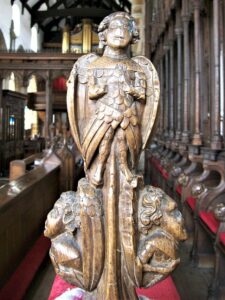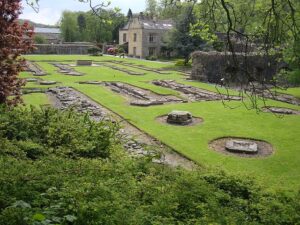Another good trip out to see the Lay Brothers dormitory one of the finest examples in the country where we were fortunate to have a peek inside to see this enormous structure that belongs to the RC English Martyrs we were lucky also to see inside this lovely church which also contained an early mediaeval statue of of Mary believed to have come from the Abbey. After looking at the Abbey ruins and a hearty lunch in the remains of the Abbots’ lodging Norman Thornber took us on a very well informed tour of the Cof E St Mary’s and All Saints Parish Church. Dating from the 13th century on a possible Anglo Saxon site, this would have been the original RC church before Henry V111’s dissolution of the monastaries.

Bench end. Whalley Church. Attribution: Poliphilo
It is mentioned in the Domesday book there are three listed Anglo Saxon crosses in the churchyard. There is so much to see and absorb in this fascinating church, it is well worth a repeat visit and spending a couple of hours getting to grip with all that is there in the interior and exterior. The misericords in particular are beautifully executed and deserve “nationwide repute” and were transferred from the Abbey after the Dissolution, like wise the choir canopy another fine example of craftsmanship.

Whalley Abbey ruins. Attribution:John Armagh
A really convivial group of people who seemed to enjoy themselves, of course the lovely spring weather helped us along too.
Did you know?
That another name for a misericord is mercy seat, when folded back the underside carving on the seat provides a small ledge for people to rest on whilst standing during long periods of prayer. Possibly up to ten hours daily.
That there were about 3 lay brothers for every monk at Whalley Abbey?
That the Abbot paid for musicians to entertain the monks whilst they ate in the Refectory.
Banner Image: Attribution: Craig Thornber